Green Hydrogen to replace non-renewable energy sources in the short, medium and long term still has great challenges to overcome.
Despite the potential of H2 Verde to replace non-renewable energy sources in the short, medium and long term, there are problems that still need to be overcome for the application of H2 Verde technology.
Price
The cheaper the energy used to generate green hydrogen, the more viable it will be to expand the production chain. Investments to increase the scale and efficiency of wind and solar energy production are being directed towards the regions of the planet with the greatest potential.
In this context, China, Mongolia, Australia, Morocco and Chile stand out. In the latter, an integrated commercial plant will be built for the industrial-scale production of climate-neutral fuel (e-fuel), from the combination of hydrogen produced from wind energy and CO2 captured from the air. Called “Haru Oni”, the project will receive investments from the German federal government in the order of 8.23 million euros and has several international partners.
Green hydrogen is currently two to three times more expensive than blue hydrogen. It is estimated that green hydrogen production costs could fall 62% by 2030, to something close to a plateau of between US$1.4 and US$2.3 per kilogram. If that happens, cost parity between green hydrogen and gray hydrogen could occur between 2028 and 2034, with projections below $1 per kilogram by 2040.
Distribution and storage
Green hydrogen is an advantageous and safe alternative to store excess amounts of wind and solar energy. It is enough to direct what is left to carry out electrolysis, generate hydrogen gas and store it. It should be noted that hydrogen can also be generated by other processes, such as reforming and gasification of biomass. In addition to avoiding the waste of clean energy, this conversion is a way to maintain regularity in the supply of two types of energy, whose productive capacity fluctuates according to changes in the environment.
There are challenges around storing hydrogen in tanks due to its high volatility and flammability, but there are also safer options for keeping it stored, such as liquefying it, diluting it in natural gas, or even adding it to ammonia, in which case it can be extracted of ammonia at the final destination.
The natural gas pipelines already installed can transport diluted hydrogen (20% H2 and the rest natural gas) over distances that can exceed 5,000 km. The power transmission potential in these gas pipelines is ten times greater than that of an electric line and one eighth of the cost.
Transport
The transport sector generates 24% of global CO2 emissions due to the burning of fossil fuels such as gasoline and diesel. Of this amount, 3/4 are emitted by cars, trucks, buses and motorcycles. For this reason, more than 20 countries are working so that the sales of polluting vehicles are zero by 2035.
The goal of the global auto industry is to have 4.5 million clean battery-powered vehicles by 2030, with China, Japan and South Korea leading the way. At the same time, plans are being made to build 10,500 hydrogen filling stations for this new fleet.
In shipping, green ammonia, synthesized from green hydrogen, can power cargo ships, making it the most cost-effective way to decarbonise container traffic by 2030.
For the aviation sector, the challenge is to develop technology capable of propelling small to large aircraft with liquid hydrogen. Another option is to replace aviation kerosene with synthetic fuels, based on green hydrogen, which emit less carbon.


